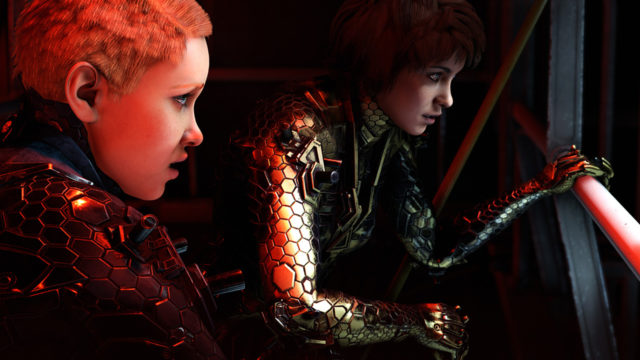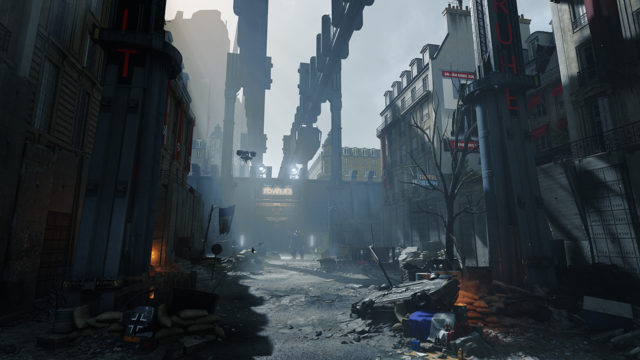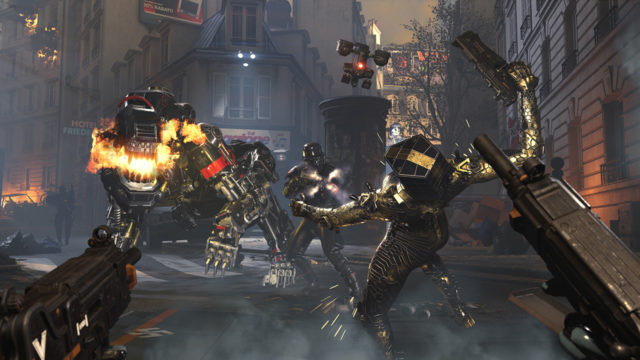Looks and sound good with minimal performance hitches; fun core shooting mechanics; pretty good co-op experience.
Odd structure fails to balance RPG and open world mechanics; extremely repetitive; some parts borderline unplayable solo.
So far, Bethesda has proven surprisingly adept at not only reviving classic franchises developed by the legendary studio Id, but also bringing those games to Switch with the help of the technical wizards at Panic Button. Doom was a faithful re-imagining of the classic shooter in a more modern context and Wolfenstein: The New Order and The New Colossus brought a surprising amount of character, heart, and story to the series that popularized blasting Nazis in video games. While Wolfenstein: Youngblood continues both the story and technical advancements from the franchise’s more recent entries, it unfortunately also stumbles in a few significant and surprising ways.
First, let’s stick with the positive: in terms of presentation, Youngblood on Switch is yet another example of how the right people can achieve amazing things on the system. As with Panic Button’s other ports of modern AAA games, there is a certain softness to the image that is noticeable at first, but once your eyes adjust, you’re more likely to be taken in by the level of fine detail in the world alongside the frequently impressive lighting and particle effects on display. Yes, other consoles and PCs will undoubtedly deliver all of this in higher fidelity, but what’s here is not just playable, but also visually pleasing. Thankfully, this technical accomplishment also carries over to general performance, which is impressively solid as moments of slowdown and dropped frames are present but never distracting.
The same praise can also be heaped upon the audio team. Guns carry a satisfying boom when fired and the sound reacts realistically based upon the environment in which it is fired. The music, while not especially memorable, is very fitting as the combat themes continue the series’ driving guitar and rock sound while the in-universe tunes feature some surprisingly catchy German synth pop that totally fits the game’s 80s setting. The voice acting is also of a similar quality, with plenty of new and returning characters delivering high quality performances largely appropriate for the style the game is going for.

Unfortunately, this general tone is where things start to crack. While the more recent games in the franchise always featured a bit of B-grade sci-fi camp, the core was surprisingly serious and very human as our hero, BJ Blazkowicz, battled desperately to restore a world he had once failed to save. In Youngblood, you assume the role of his twin daughters Jess and Soph and the opening cutscene seems to set a similar tone, but that quickly fades. The general thrust is simple: BJ has disappeared in a Nazi occupied Paris so Jess and Soph put on a pair of power suits to go and look for him while helping the French resistance along the way.
One gets the impression these girls were supposed to be kind of adorkable, and while this is achieved at times, they are generally just grating and surprisingly gung-ho at the prospect of killing countless Nazis. No, this isn’t to say Nazis are particularly worthy of sympathy, but considering how much glee the girls get from their first kill, it’s honestly kind of disconcerting. BJ was a hardened soldier from beginning to end in his games, but his daughters go from dorky kids quoting their favorite young-adult fiction books to bloodthirsty Nazi killers in literally no time.
This odd tone is then carried over into the game’s structure which can only be described as utterly baffling. Youngblood incorporates both a light RPG system in addition to a pseudo-open world made of segmented areas you deploy to from a central hub in the Paris Catacombs. In this central base, you can recover health, armor and ammo as well as pick-up side objectives from the various members of the resistance before heading out into the Nazi-infested streets. Each objective is kind of like a small open world, albeit one with clearly defined zones that annoyingly respawn enemies every time you reenter them. Furthermore, side missions, alongside random option objectives that pop-up from time to time, often repeatedly send you back to the same areas over and over again to fulfill very similar objectives. The actual structure of the world is somewhat interesting as there is an almost Metroid-like element thanks to areas that require certain skills and equipment to access as well as new, somewhat hidden routes you can uncover, but eventually a sense of repetition definitely settles in.

But repeat you must, as Youngblood demands at least a certain measure of grinding thanks to the new RPG mechanics. First, there is your character level, which grants you damage buffs and skill points as you amass experience from defeated foes and completed quests. Skill points can be used to customize certain aspects of your character such as the length and effectiveness of their cloak ability, total armor and health pools, how much ammo you can carry, and so on. The stealth ability is surprisingly useful, though not in the way you would think. The way enemy level scaling works actually makes truly stealth focused combat largely pointless, but being able to remained cloaked longer is very useful for simply avoiding the more repetitive fights found throughout the open world. Silver coins are also found throughout your playtime and they are primarily used to customize your weapons; while this is a great option for tweaking weapons to match your play style, the relatively limited overall selection of guns is ultimately still stifling.
The really sad thing is that combat could, and in fact often does, feel really fun. The core mechanics are all solid as the controls are responsive and your character’s agility and the overall verticality of the level design makes things interesting, at first. Most random fights are easy enough, but as you approach the more tailored encounters found in major missions featuring wide varieties of enemies, you will likely come to hate the new enemy health system. Every foe features a health bar over their head in red, while many also have armor represented in white. However, there are two types of armor based on whether that white bar is divided into smaller or larger segments, a distinction that is meant to tell you which of your guns is most effective against that armor. Conceptually this idea isn’t horrible, but in the heat of battle it’s frustrating, especially as you are often dealing with many enemies at the same time with varying weaknesses. Plus, there’s the general frustration of dumping a shotgun blast into an enemy at pointblank range only to see it have no discernible effect on the foe because of his armor type. Of course, there’s also the annoying aspect of level gating, where certain areas are simply inaccessible due to the presence of a much higher level foe who will instantly kill you.
Main missions are a little different as they revolve around taking down the four Brothers, massive tower fortresses from which the Nazis rule over Paris. These levels are more straightforward and specifically crafted with thoughtful enemy groupings and level designs. However, this is where the potential weaknesses of the co-op focus start to show. When playing with a partner, everything is improved as you can work together to better coordinate weapon choice and target selection as well as more easily revive each other when you are low on health. Voice chat is even included! Solo play also works well most of the time as the AI will take control of the other sister and is generally decent at reviving you, staying stealthy, and taking down the occasional enemy with only occasional hiccups. But this all falls apart with the bosses of the story mode where your partner AI is simply too aggressive and the bosses too powerful. The cherry on top: when you ultimately fail, you don’t get sent back to a pre-boss fight check point: you get sent back to the start of the mission. Seeing how these levels are literally the main focus of the game, it might as well make the whole experience completely pointless for those looking to play solo.

What’s hard to put into words is just the overall sense of flow all of this ultimately creates. Most battles play out well enough, but eventually you will realize how you are just constantly revisiting the same areas over and over again as you grind out the experience and currency needed to make you strong enough to tackle the next major objective. Many games do this, but the actual size of Youngblood is actually much smaller than its peers and its weapons and abilities, while fun to use at first, don’t have the same variety to support the repetitive grind. Furthermore, many side missions have you jumping between areas, something that might feel seamless in a full open world but is really choppy here as you load in and out of each area. Take into account the daily and weekly challenges, and you get the impression the developers were attempting to create something more along the lines of Destiny or Warframe, but there just isn’t the actual variety of locations, mechanics, and content to support the concept.
All told, Wolfenstein: Youngblood is a rather baffling experience that doesn’t quite seem to fully understand what it’s trying to be. Many of the factors that made previous games enjoyable are still here: the core gameplay mechanics are solid and the presentation is legitimately impressive considering Switch’s hardware limitations. However, the changes they made both in terms of structure and the addition of RPG mechanics simply don’t work together in a cohesive way. Furthermore, the option to play co-op or solo works 99 percent of the time but that missing one percent is frustrating to the extent that it is almost game breaking. With some significant updates and changes, it feels like the game could definitely be salvaged and made into something legitimately good, but as it stands now, Youngblood can only be recommended as a dedicated co-op experience and even then it has to come with a warning about the general repetition and faulty structure.
Nintendojo was provided a copy of this game for review by a third party, though that does not affect our recommendation. For every review, Nintendojo uses a standard criteria.




 ShareThis
ShareThis





